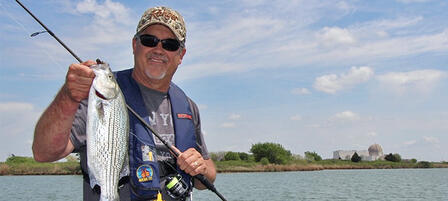KDWPT, KDHE Announce Clearest Lakes in Kansas

PRATT – The Kansas Department of Wildlife, Parks and Tourism (KDWPT), in partnership with the Kansas Department of Health and Environment (KDHE), has a new “bucket list” for Kansas kayakers, anglers, and outdoor enthusiasts to pursue – recreating at Kansas’ clearest lakes. Aquatic vegetation, underwater structures, and even fish may be visible at these lakes, providing a unique view of what lies beneath the waters’ surface. From paddleboarders looking for that Instagram-worthy photo, to anglers after the ultimate fishing challenge, Kansas’ clearest lakes should be a part of your 2020 travel plans.
Kansas Clearest Lakes for 2020
1) Cherokee County, Mined Land Wildlife Area – Mined Land Lake 17; 13.1 feet of clarity
2) Crawford County, Mined Land Wildlife Area – Mined Land Lake 04; 12.3 feet
3) Cherokee County, Mined Land Wildlife Area – Mined Land Lake 27; 12.3 feet
4) Cherokee County, Mined Land Wildlife Area – Mined Land Lake 12; 11.2 feet
5) Crawford County, Mined Land Wildlife Area – Mined Land Lake 07; 11 feet
6) Cherokee County, Mined Land Wildlife Area – Mined Land Lake 30; 10.3 feet
7) Russell and Lincoln Counties, Wilson Reservoir; 9.9 feet
8) Crawford County, Bone Creek Lake; 8.4 feet
9) Trego County, Cedar Bluff Lake; 7.9 feet
10) Douglas County State Fishing Lake; 7.7 feet
11) Wyandotte County Lake; 7.7 feet
12) Johnson County, Shawnee Mission Park Lake; 7.5 feet
13) Bourbon County, Cedar Creek Lake; 7.2 feet
14) Morris County, Council Grove City Lake; 7.1 feet
15) Pottawatomie County State Fishing Lake #2; 6.7 feet
16) Bourbon County, Fort Scott City Lake; 6.6 feet
17) Wabaunsee County, Alma City Lake; 6.3 feet
18) Osage County State Fishing Lake; 6 feet
19) Lyon County State Fishing Lake; 5.9 feet
20) Chautauqua County, Sedan City Lake South; 5.3 feet
21) Woodson County, New Yates Center Lake; 5.2 feet
22) Osage County, Melvern Lake; 5 feet
23) Barber County State Fishing Lake; 4.7 feet
24) Chase County State Fishing Lake; 4.7 feet
25) Shawnee County State Fishing Lake; 4.5 feet
26) Coffey County Lake; 4.3 feet
27) Greenwood County, Madison City Lake; 4.2 feet
28) Cherokee County, Mined Land Wildlife Area – Mined Land Lake 44; 4.1 feet
Each year, KDHE environmental scientist, Layne Knight, selects waterbodies from a list of 358 locations on the Kansas Surface Water Register to test for water clarity. Listed federal reservoirs are sampled every three years, state fishing lakes every four years, while remaining waterbodies are sampled every six years.
“Water clarity in Kansas reservoirs is affected primarily by either algae or suspended sediments,” said Knight. “It’s a good indicator of the level of human impact in a watershed.”
In the field, Knight uses techniques such as Secchi depth – a disk lowered through a water column until it disappears from view – to measure water column transparency. Water samples are then submitted to a laboratory to test turbidity, a measurement of how well light passes through the sample, and total suspended solids, the number of suspended particles. Chlorophyll analyses are also conducted and used as an indicator of the level of algae growth in the system; Lakes are then ranked based on results.
Apart from the scientific data agencies are able to obtain from these tests, recreational benefits exist, as well. In fact, increased water clarity enhances your angling experience because you can see bottom structure, your lure and ultimately a fish on the end of your line, which adds a unique element of excitement.
“In general, fish in clear water will behave different from fish in turbid water,” said KDWPT fisheries biologist, Jeff Koch. “Fish in clear water will be more wary, so you have to change up your technique if you want to be successful.”
Anglers fishing in clear waters should concentrate their efforts during low-light periods or with a light chop on the water when fish will be most comfortable feeding. Since fish can see better in clear water, use a light low-visibility line such as fluorocarbon and make long casts. Also, baits that closely resemble natural prey, such as shad, bluegill, or crawfish in realistic colors will draw more strikes. Koch also suggests using small finesse-type baits in natural colors.
“You won’t need to throw great big lures to get their attention and draw them in,” added Koch. “Stick to what looks real, and you’ll find a fish on the end of your line.”
For more on fishing in Kansas, visit ksoutdoors.com/Fishing.
For more on lake monitoring in Kansas, visit www.kdheks.gov/befs/lakes_monitoring.htm
-30-







